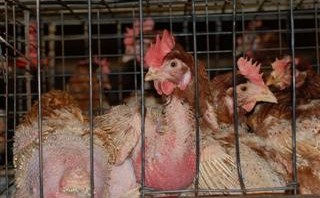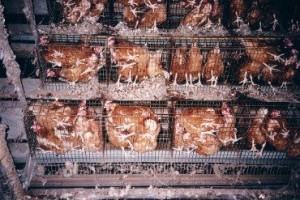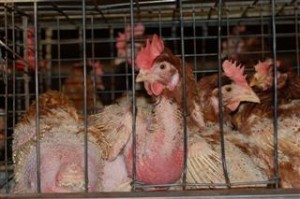
 Why did the chicken cross the road? I’ll tell you later.
Why did the chicken cross the road? I’ll tell you later.
Chickens. Aren’t they wonderfully interesting and interested creatures? Could there be anyone who doesn’t like the humble chicken, who isn’t mesmerised by this fancy bird’s walks and squawks and scratchings in the good earth?
There are those of us who love our chickens for their bountiful eggs and helpful functions like pest control, composting and social value. And there are those, for whatever reason, who see the chicken, as with many other animals, as purely a source of profit, willing to subject this intelligent, inquisitive, highly interactive bird to all kinds of tortures and exploitations to make a buck. Hundreds of millions of them every year!
Like many of us, I grew up with chickens. I cannot remember an age or stage of life when we didn’t have multiple chooks on our farms. My father has bred champion Wyandottes for as long as I can remember. Bird flu jokes aside, I think chickens are in my blood. I absolutely love keeping chickens and am lucky to encourage and share this pleasure with others as part of my work and projects and one of those projects is The KFC Project.
Since I was a small child, we always had lots of different animals, including many rescued pets and wildlife. I have always been involved with rescue animals in some way and over the years have rescued my share of chickens from various farms and sources, giving them a second chance at life. Last year, however, we decided to create a project that formally rescues battery hens from caged egg farms and re-homes them with backyard chook lovers. It’s a win-win for all – the hens get a free new life and the adopters get to enjoy a wonderful experience. The project also continues to create awareness of the plight of around 12 million hens that suffer from birth to death every year in Australia, just for their eggs. That figure doesn’t include chickens used for other purposes.
The KFC (Kindness For Chickens) Project launched officially on Friday 1 June 2012 (the first day of winter). On Tuesday 5 June, we rescued ‘officially’ our first 5 hens from a Redlands Bay caged egg farm.
 For anyone who has not been to such farms, and who is an animal lover, it is a very challenging place to visit – even with the intention of liberating some hens. The sheds (like holocaust buildings) house tens of thousands of hens. The noise, smell and sight are appalling. How it is allowed and legal, on any level, is beyond belief, and many of these farms are operating illegally in terms of cage size, conditions and animal welfare laws. In summer the sheds are like ovens. In winter it’s a long cold night for mostly featherless hens who huddle together in cold steel cages with steel mesh floors. There is no stimulation, no comfort, no hope, 24 hours a day, 365 days a year, if they live that long. The hens go into the cages (after being ‘free range’ in large sheds) at around 15 weeks old to ‘settle in’ to their new nightmare. There they remain for between 12 and 18 months. At the end of their ‘commercial productivity’ they are culled – sent on mass to abattoirs for various purposes. Like all commercially exploited animals, it is a soulless, cruel and deeply sad short life.
For anyone who has not been to such farms, and who is an animal lover, it is a very challenging place to visit – even with the intention of liberating some hens. The sheds (like holocaust buildings) house tens of thousands of hens. The noise, smell and sight are appalling. How it is allowed and legal, on any level, is beyond belief, and many of these farms are operating illegally in terms of cage size, conditions and animal welfare laws. In summer the sheds are like ovens. In winter it’s a long cold night for mostly featherless hens who huddle together in cold steel cages with steel mesh floors. There is no stimulation, no comfort, no hope, 24 hours a day, 365 days a year, if they live that long. The hens go into the cages (after being ‘free range’ in large sheds) at around 15 weeks old to ‘settle in’ to their new nightmare. There they remain for between 12 and 18 months. At the end of their ‘commercial productivity’ they are culled – sent on mass to abattoirs for various purposes. Like all commercially exploited animals, it is a soulless, cruel and deeply sad short life.
From then on we managed to rescue between 5 and 15 hens each week through the year, until it became difficult to obtain more hens from the farms we were working with, around November 2012. One farm reportedly stopped stocking caged hens (which, if true, is a win for the hens). One farm didn’t want to deal with us anymore. And others have closed – another win for chickens. Our focus now will turn to other areas around SE Qld and also to ‘free range’ hens, which live in large sheds, in crowded numbers, and never see day light. They also face the same fate as caged hens and deserve a second chance.
 To date we’ve rescued and re-homed just over 100 chickens, including around 25 hens and roosters that have come through the project from private sources and via the RSPCA Brisbane. The real work has been done by all those who have supported the project, adopted and fostered rescue hens and other chickens, and opened their hearts and homes to these amazing birds, who just need a good feed, a warm bed and an occasional cuddle from caring hands. Rescued battery hens have been adopted as close as my neighbours and as far as Bundaberg. We’ve lost a few along the way, but the survivors have all gone to great homes.
To date we’ve rescued and re-homed just over 100 chickens, including around 25 hens and roosters that have come through the project from private sources and via the RSPCA Brisbane. The real work has been done by all those who have supported the project, adopted and fostered rescue hens and other chickens, and opened their hearts and homes to these amazing birds, who just need a good feed, a warm bed and an occasional cuddle from caring hands. Rescued battery hens have been adopted as close as my neighbours and as far as Bundaberg. We’ve lost a few along the way, but the survivors have all gone to great homes.
One of the innovative and unique things we did, in order to rescue and place as many hens as possible, was to kickstart a foster carer program. Interested and committed people were trained in rescue hen care and took between 3 and 10 hens at any given time to care for temporarily, until permanent homes were found. This provided a great experience for families wanting to trial keeping chickens and enjoy that experience, but most importantly, enabled us to rescue a lot more hens each time. I am only physically and legally able to host a certain number of hens personally, so the foster carers really took pressure off myself and freed a lot more hens than would normally be possible. Hats off to them all.
Now I’m expecting that this story will generate some interest in the project and people wanting hens. Currently we DO NOT have any hen, and none foreseen to be coming anytime soon. The best action you can take now is to Like the KFC Project page (link below) so we can keep you updated when we have hens available for adoption. In the meantime, have a look at the photos of our lovely naked rescue girls in the albums below on Facebook.
Tomorrow I’ll share with you the story of Mu – the rescue hen that stole our heart.
So … why did the chicken cross the road? To get to the KFC Project, of course!
For more info on the project, please visit the KFC Project webpage:
http://greendean.com.au/the-kfc-project
The first official 5 hens rescued on 5 June 2012: (Facebook album)
http://www.facebook.com/media/set/?set=a.186998521426690.38008.161202637339612&type=3
Please join our official KFC Project Facebook page:
http://www.facebook.com/pages/The-KFC-Project/161202637339612
